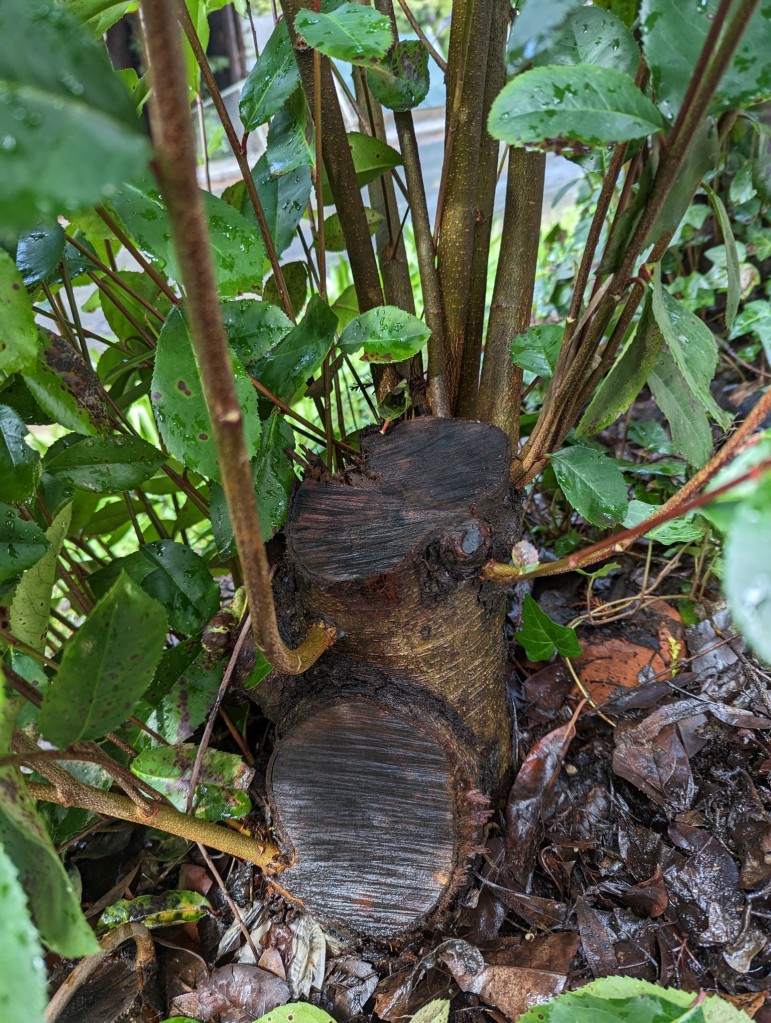
Pollarding is extreme pruning. It removes all but the most substantial of limbs and trunks. Coppicing is even more extreme. It leaves only stumps above ground. Both are common and respected arboricultural techniques outside America. However, they are vilified here. Actually, very few arborists here know how to pollard and coppice properly, or admit to it.
There are many valid reasons to pollard or coppice trees or big shrubs. Both techniques stimulate vigorous growth. Lush foliage of such growth is useful as fodder, particularly for silkworms. Elongated stems of such growth are useful for basketry and kindling. Species that bloom on older stems can not produce pollen or messy fruit after annual procedures.
Although silkworms, basketry and such are unimportant within an average home garden, proper pollarding or coppicing enhances vigor. This enhances the bloom of species that bloom on new stems. Vigorous growth of pollarded crape myrtle is atypically resistant to mildew, and also blooms zealously. Coppice pruning eliminates unsightly thicket growth.
Pollarding is generally useful for trees and large shrubs that retain primary trunks. Only a few of the many species that inhabit home gardens are conducive to it. Since secondary growth is initially structurally deficient, it will most likely need subsequent pruning during subsequent winters. Some vigorous pollarded trees are dependent on annual pollarding.
Coppicing is generally useful for large and vigorous shrubbery, and perhaps a few types of trees. Coppiced shrubbery is not as reliant on subsequent pruning as pollarded trees. They either benefit from pruning as they grow anyway, or do not get too heavy to support their weight. Both coppice and pollard pruning can happen only during winter dormancy.
Realistically, the majority of plants in home gardens are conducive to neither coppice nor pollard pruning. Cypress hedges die if cut back to stumps. Grafted plants, even if pruned above their graft unions, are likely to regenerate from their understock. However, some of the most popular hedge plants, such as privet, holly, photinia, osmanthus, English laurel and bottlebrush regenerate splendidly.








 Just about any other arborist will insist that any pollard is a bad pollard. I am not any other arborist. I have no issue with pollarding certain trees properly.
Just about any other arborist will insist that any pollard is a bad pollard. I am not any other arborist. I have no issue with pollarding certain trees properly.





 Pollarding and coppicing are proper pruning techniques. If you think you are an arborist who believes otherwise, do not waste my time arguing about it. More than likely, you are neither as educated nor as experienced as I am with such matters, or you work exclusively with trees for which such procedures would be very inappropriate.
Pollarding and coppicing are proper pruning techniques. If you think you are an arborist who believes otherwise, do not waste my time arguing about it. More than likely, you are neither as educated nor as experienced as I am with such matters, or you work exclusively with trees for which such procedures would be very inappropriate. This is the beginning of one of several new knuckles on a pollarded crape myrtle tree that was pollareded for the first time just this past winter. It was quite a mess of thicket growth that was too congested to bloom well. It is also located in a confined situation where it could not just be groomed, pruned up for clearance, and then just left to develop a larger canopy higher up. Pollarding will both contain it, as well as invigorate healthier growth.
This is the beginning of one of several new knuckles on a pollarded crape myrtle tree that was pollareded for the first time just this past winter. It was quite a mess of thicket growth that was too congested to bloom well. It is also located in a confined situation where it could not just be groomed, pruned up for clearance, and then just left to develop a larger canopy higher up. Pollarding will both contain it, as well as invigorate healthier growth.